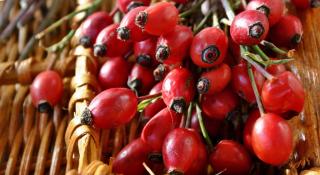

Often thought of as a wild plant, dog rose –the rose-hips, specifically– has many health benefits that help cure body ailments.
This plant belongs to the Rosaceae family, and has many names. It’s easily recognizable since it looks a lot like thorny rose bushes. It has pink or white flowers and bears red fruit called rose hips.
These fruits are accordingly laden with amazing medicinal properties. Which ones? Let’s have a look around…
Dog rose was formally described in 1819 by an English seaman and explorer.
 The origin of the name of the plant comes from ancient Greek kunorodon and Latin Rosa canina, all of which mean “dog rose”. Another latin name for the plant is aquilentum which means “that which has thorns” from the word acus which means “spike”.
The origin of the name of the plant comes from ancient Greek kunorodon and Latin Rosa canina, all of which mean “dog rose”. Another latin name for the plant is aquilentum which means “that which has thorns” from the word acus which means “spike”.
Rose hip is known for its culinary, medicinal and cosmetic value. The term designates the fleshy hull that is wrapped around the seeds of both rose tree and dog rose.
Medicinal use of the plant dates back to Hippocrates who used its roots to heal a wound caused by a dog’s bite (hence the name Rosa canina or dog rose).
In the XVIIth century, the dog rose fruit was used to soothe diarrhea.
Note that another name connected to this plant, eglantine, describes the flower itself, not the fruit.
In Ancient Greece, this flower was used to treat colds and throat inflammation.
This plant with high vitamin C content was very useful during World War II: English commanders distributed it to the front lines to bolster soldier health.
American Indians had an entirely different purpose for this plant. They affirmed that those who would eat the hairs in the fruit would suffer atrocious pain at their rear end.
Dog rose is a thorny rose tree that can grow up to 10 feet (3 meters) tall.
Whether it’s called wild rose, hedge rose, dogberry or witch’s briar, this plant bear edible fruits called rose hips. These are used in cooking, in the medical field and in cosmetics.
Since Roman times, dog rose flower petals have been used in infusions to flavor pastries.
Although the petals were eaten directly in some cultures, others would prepare a decoction from it and turn it into beer.
Alaskan eskimos prepared a type of pudding from it: mashed rose hip flesh, water, seal oil and sugar) or would add the dog rose berries to a meal of pre-chewed salmon tails.
Other Alaskan tribes either paired them with fish spawn or fat to make ice cream.
Some would use it to season meals baked under cinders, or would crush it and blend into pemmican.
Today, in places that aren’t so extreme, the edible portion of the dog rose berry is either prepared alone or with other fruits in the form of jam, syrup, ketchup, jelly or marmalade.
In Armenia, people find rose hip juice delicious.
In Sweden, rose hip soup is a dessert usually served with cream, milk and vanilla ice cream.
Chechen know rose hip tea very well: it is a culinary staple food.
It also contains vitamin B, vitamin PP, provitamin A and minerals.
This is a choice plant for persons wanting to follow a dietary course at the beginning of winter. It has often been used to fight off the flu and, more generally, infections.
On top of that, when used as a tonic for its invigorating effects on the immune system, rose hip has medicinal properties known to treat asthenia.
In China, berries from various cultivars are used to treat chronic diarrhea and urinary disorders.
In Denmark, scientists have shown that dog rose berries has properties that tend to alleviate arthritic pain.
When drunk in infusions, dog rose flower petals are used to fend off headaches and treat dizziness.
Note also that rose hip syrup is often mixed into children’s medicine to make it taste better.
Aside from the anti-anemic, anti-diarrhea, diuretic, antiseptic, tonic and haemostatic properties, without forgetting the astringent effects of dog rose petals, this wild rose tree used for centuries for medicine is now making a foray into organic cosmetics.
Indeed, rose hip releases a plant-based oil that boasts many benefits. This plant with high vitamin C levels also hoards flavonoids, malic and citric acid, tannin compounds, and carotenoids.
These days, demand in terms of rose hip oil availability has increased thanks to its anti-ageing, antioxidant and regenerative properties.
It is known to regenerate skin cells and damaged tissue, erases post-partum skin imperfections, stretch marks, post-operative scarring, acne scars, dry dermatitis, burns and sunburns.
This 100% natural oil is also quite beneficial to damaged or stressed hair.
The best season to harvest dog rose is from June to September.
Today, studies show that there are no toxic side-effects if recommended doses are followed.
Whether in jams, mashed fruit sauce or flavoring and herbal tea, dog rose hip is always a hit. Since it keeps its properties very well, you can dry it or store it in the freezer.
To fight against tiredness, colds, vitamin C deficiency, flu symptoms, simply drink an infusion prepared from this plant.
Measure out 2 table spoons of dried pulp. Break it up into pieces. Plunk this in 1 quart (1 liter) cold water (or about 2.5 g per cup). Bring to boil. Let steep for 10 minutes. After that, filter and drink. Drink 3 cups a day.
To treat diarrhea, boil 1 quart (1 liter) water. Toss about 1 to 1½ oz (30 to 50 g) chopped rose hip in and boil for 5 minutes (low heat). Cut the heat and steep for ¼ hour. Filter. Drink to wit for breakfast until symptoms subside.
Rose hip is also effective in the form of wine or elixir.
This means that after macerating in alcohol, sugar is added.
– Base tincture: count 40 drops in a glass of water. Drink thrice a day, and, this is important, before meals.
– Capsules: 50-200 mg dry extract: swallow 1 or 2 capsules with a large glass of water, 3 times a day (before meals).
 Before winter settles in for good, harvest the dog rose berries, wash them in flowing water and sponge them dry.
Before winter settles in for good, harvest the dog rose berries, wash them in flowing water and sponge them dry.
Using plants for self-medication or to alleviate pain deserves serious consideration.
Always ask an expert and never exceed recommended doses.
If symptoms persist, it is always recommended to follow through with a medical consultation.